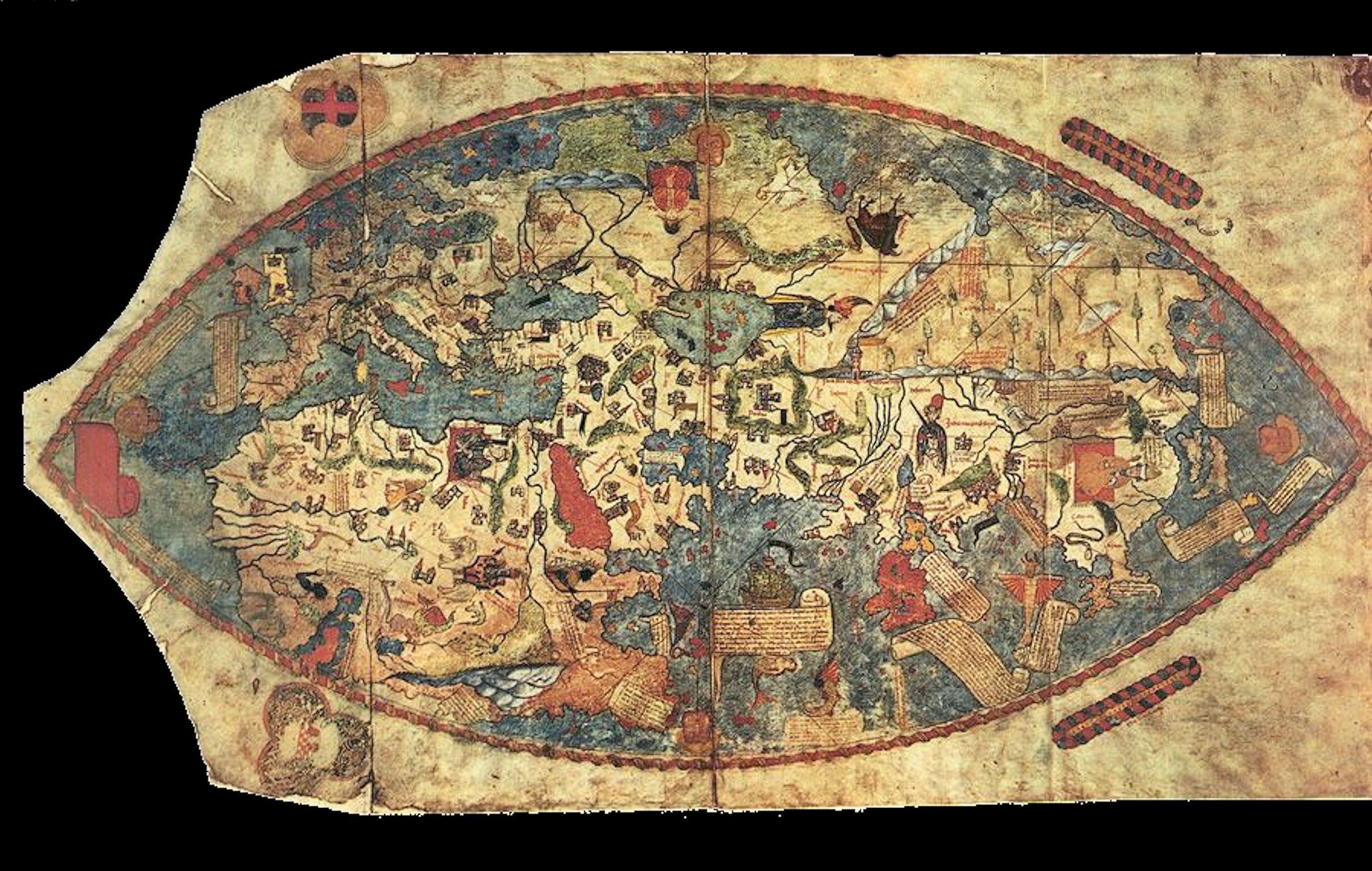Genoese Map on:
[Wikipedia]
[Google]
[Amazon]

 The Genoese map is a 1457
The Genoese map is a 1457
The Genoese map's sea monsters reflect the cartographer's interest in exotic wonders, which is everywhere in evidence on the map, and typical of the scientific outlook of the early modern period, which was driven by curiosity and took a great interest in marvels. The demon-like monster in particular is evidence of the cartographer's research in recent travel literature to find sea monsters for his map. This map was done in rich color and was not made particularly used for anything but for display. They say this map was sent to the Portuguese court in 1474 and then to Columbus and this is the map that he used to travel the India sea to the Atlantic but was never proven. The map is now the property of the Italian government and is to be found in the Biblioteca Nazionale Centrale of Florence. The oval form is not unknown among medieval maps. Hugh of Saint Victor had described the world as being the shape of Noah's Ark, and Ranulf Higden world maps were oval. A standard way of describing the earth was to compare it to an egg. The main purpose of the analogy seems to have been to describe the various spheres surrounding the earth (egg white, shell), but the idea of an egg shape could have been derived from these works. Another possibility is that the oval form represents the ''mandorla'', or nimbus, which surrounded Christ in many medieval works of art.
Engineering Historical Memory
World maps 1457 works 15th-century maps and globes {{cartography-stub

 The Genoese map is a 1457
The Genoese map is a 1457 world map
A world map is a map of most or all of the surface of Earth. World maps, because of their scale, must deal with the problem of map projection, projection. Maps rendered in two dimensions by necessity distort the display of the three-dimensiona ...
. The map relied extensively on the account of the traveler to Asia Niccolo da Conti, rather than the usual source of Marco Polo
Marco Polo (, , ; 8 January 1324) was a Venetian merchant, explorer and writer who travelled through Asia along the Silk Road between 1271 and 1295. His travels are recorded in ''The Travels of Marco Polo'' (also known as ''Book of the Marv ...
. The author is not known, but is a more modern development than the Fra Mauro world map, with fairly good proportions given to each continents. The map also depicts a three-masted European ship in the Indian Ocean
The Indian Ocean is the third-largest of the world's five oceanic divisions, covering or ~19.8% of the water on Earth's surface. It is bounded by Asia to the north, Africa to the west and Australia to the east. To the south it is bounded by th ...
, something which had not occurred yet at the time.
A Genoese flag in the upper northwest corner of the map establishes this map's origin, along with the coat of arms of the Spinolas, a prominent Genoese mercantile family. Niccolò de'Conti was from a noble mercantile family; at an early age he decided to follow in the family tradition by establishing a lucrative trading operation in the EasThe Genoese map's sea monsters reflect the cartographer's interest in exotic wonders, which is everywhere in evidence on the map, and typical of the scientific outlook of the early modern period, which was driven by curiosity and took a great interest in marvels. The demon-like monster in particular is evidence of the cartographer's research in recent travel literature to find sea monsters for his map. This map was done in rich color and was not made particularly used for anything but for display. They say this map was sent to the Portuguese court in 1474 and then to Columbus and this is the map that he used to travel the India sea to the Atlantic but was never proven. The map is now the property of the Italian government and is to be found in the Biblioteca Nazionale Centrale of Florence. The oval form is not unknown among medieval maps. Hugh of Saint Victor had described the world as being the shape of Noah's Ark, and Ranulf Higden world maps were oval. A standard way of describing the earth was to compare it to an egg. The main purpose of the analogy seems to have been to describe the various spheres surrounding the earth (egg white, shell), but the idea of an egg shape could have been derived from these works. Another possibility is that the oval form represents the ''mandorla'', or nimbus, which surrounded Christ in many medieval works of art.
See also
* Ancient world mapsNotes
References
* * http://www.myoldmaps.com/late-medieval-maps-1300/248-the-genoese-map/ * http://biography.yourdictionary.com/niccolo-de-contiExternal links
* Interactive scholarly edition, Deep Zoom feature, highlighted details, English and Chinese translation, multimodal resources mashup (publications, images, videos). LinEngineering Historical Memory
World maps 1457 works 15th-century maps and globes {{cartography-stub